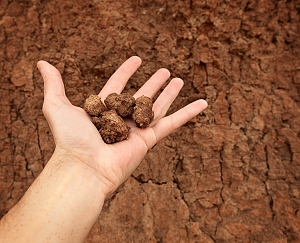Whether you are an experienced farmer or a hobbyist gardener, understanding the intricacies of the land is crucial for successful cultivation. The various types of dirt play distinct roles in the growth process, necessitating a comprehensive knowledge of their characteristics and applications.
Identifying the Four Soil Types
Embarking on the journey of understanding soils involves delving into the distinctive characteristics of the four primary soil types. Each type plays a unique role, in shaping the landscape of gardening and farming practices:
Dust
 Dust, with its powdery composition derived from organic or mineral sources, is a ubiquitous presence in our surroundings. It tends to accumulate on surfaces, especially those crafted from wood. While seemingly innocuous, the particles in dust contribute to the overall ecosystem, and understanding its properties aids in maintaining a healthy environment.
Dust, with its powdery composition derived from organic or mineral sources, is a ubiquitous presence in our surroundings. It tends to accumulate on surfaces, especially those crafted from wood. While seemingly innocuous, the particles in dust contribute to the overall ecosystem, and understanding its properties aids in maintaining a healthy environment.
Filth
The term “filth” speaks to a less savory aspect of soil composition. It encompasses foul excrement and is distinctly unsanitary compared to other soil types. Despite its unappealing nature, filth, like other soils, is part of the intricate web of ecological processes. Recognizing its presence prompts proper handling and disposal practices, ensuring a hygienic environment.
Grime
Embedded within dust, grime adds another layer of complexity to soil composition. It includes substances such as soot, often originating from chimneys and contributing to ingrained dirt. Grime’s presence highlights the interconnectedness of natural elements, emphasizing the need for comprehensive soil management practices to address not just the surface but also the deeper layers.
Soil
Among the four soil types, “soil” is the most familiar, encountered in the ground during various agricultural activities. It represents a loose layer of earth formed over centuries through the gradual breakdown of bedrock and rocks facilitated by air and water. This foundational soil type serves as the canvas for gardening and farming endeavors, providing the essential substrate for plant growth.
Understanding these four soil types is more than a mere classification; it is a gateway to appreciating the intricate balance within ecosystems. Each type contributes to the overall health of the environment, and by recognizing their unique characteristics, individuals can make informed decisions about soil management, fostering sustainable practices in agriculture and gardening
Exploring Soil Varieties and Their Roles
Diving deeper into the world of soils reveals a rich tapestry of types, each with its distinct attributes and roles in the intricate dance of nature. Understanding these key soil varieties is paramount for anyone involved in agriculture or gardening, as it paves the way for informed decision-making and successful cultivation.
Clay Soil
 Densely packed with minimal air, clay soil stands out for its remarkable ability to retain significant amounts of water and nutrients. This characteristic makes it an ideal choice for cultivation in milder temperatures. However, its dense nature poses challenges during extreme weather conditions. To address this, protecting compost coverage becomes essential, ensuring the preservation of its unique properties.
Densely packed with minimal air, clay soil stands out for its remarkable ability to retain significant amounts of water and nutrients. This characteristic makes it an ideal choice for cultivation in milder temperatures. However, its dense nature poses challenges during extreme weather conditions. To address this, protecting compost coverage becomes essential, ensuring the preservation of its unique properties.
Silty Soil
Smooth in texture and proficient at holding water, silty soil emerges as an agricultural gem. Its water-retention capability makes it an ideal substrate for crops. However, this soil type comes with a caveat—it lacks native nutrients. To overcome this limitation and facilitate efficient crop growth, supplementation with additives becomes a crucial practice, underscoring the importance of a balanced approach to soil management.
Loamy Soil
The epitome of balance, loamy soil is a harmonious blend of clay, sand, silt, and humus. This versatile soil type is nutrient-rich, creating an optimal environment that supports a diverse range of produce and crops. Its balanced composition minimizes the need for extensive additives, making it a go-to choice for various planting endeavors.
Sandy Soil
Characterized by dryness and poor water retention, sandy soil presents challenges for plant growth. Its propensity to hinder root establishment and support minimal life necessitates strategic interventions. Gardeners and farmers dealing with sandy soil must employ irrigation methods and nutrient-enriching practices to overcome its limitations and foster a conducive environment for plant development.
Peaty Soil
Dark brown to black, peaty soil emerges as a gardening delight. Rich in organic material and boasting high water-holding capacity, it provides an excellent foundation for plant growth. Despite its acidity, peaty soil’s pH levels can be balanced by mixing it with low-acidic soils. Drainage considerations may be required before planting, given its high water content.
Chalky Soil
Derived from limestone beds with chalk deposits, chalky soil presents unique challenges for growers. Its dryness and high acidity make it difficult to manipulate and grow plants in. Planting in chalky soil can result in crops turning yellow due to elevated acidic levels. Effective management strategies, including soil amendments, are crucial to mitigate these challenges and optimize conditions for successful cultivation.
In essence, comprehending the roles of these diverse soil varieties is akin to deciphering nature’s code. Armed with this knowledge, gardeners and farmers can tailor their practices to the specific needs of different crops, fostering a harmonious relationship between soil and cultivation.
Essential Facts for Potential Buyers of Dirt
For those considering the purchase of dirt, whether for construction projects, gardening, or landscaping, it’s crucial to be well-informed about the key factors that can influence the quality and suitability of the soil. Understanding these facts ensures that buyers make informed decisions and obtain dirt that aligns with their specific needs and goals.
Soil Composition
Dirt is not a uniform entity; it comes in various compositions, each with its unique characteristics. Before making a purchase, buyers should inquire about the soil composition, considering aspects such as clay content, sand, silt, and organic matter. This knowledge helps in selecting dirt that suits the intended purpose, whether it’s providing stability for construction or promoting optimal plant growth.
Testing and Analysis
 Reputable sellers often conduct soil testing and analysis to assess its quality. Buyers should request information about these tests, which can include measurements of nutrient levels, pH, and compaction. Such data provides valuable insights into the soil’s fertility, drainage capabilities, and overall suitability for specific applications.
Reputable sellers often conduct soil testing and analysis to assess its quality. Buyers should request information about these tests, which can include measurements of nutrient levels, pH, and compaction. Such data provides valuable insights into the soil’s fertility, drainage capabilities, and overall suitability for specific applications.
Source and Origin
Understanding the source and origin of the dirt is essential. Different regions may have distinct soil types, and the geological characteristics of the area can influence the dirt’s properties. Buyers should inquire about the soil’s origin to ensure that it aligns with their project requirements.
Contaminants and Impurities
Contaminants in soil can have significant implications, especially for projects involving gardening or construction. Buyers should be aware of any potential contaminants or impurities in the dirt, such as heavy metals or harmful chemicals. Requesting information about soil quality in terms of purity is crucial for projects where clean, uncontaminated dirt is paramount.
Moisture Content
The moisture content of dirt plays a vital role in its workability. Soil that is too wet or too dry can pose challenges for various applications. Buyers should inquire about the moisture content of the dirt they are considering and ensure it aligns with the intended use. This is particularly important for construction projects where soil stability is critical.
Delivery Logistics
Practical considerations such as the logistics of dirt delivery should not be overlooked. Buyers should discuss delivery options, transportation costs, and scheduling to ensure a smooth and timely arrival of the purchased dirt. Understanding these logistics helps avoid delays and ensures that the dirt is delivered in the desired quantity and condition.
Environmental Regulations
Buyers should be aware of any environmental regulations or restrictions related to the purchase and use of dirt in their region. Compliance with local laws ensures responsible and sustainable practices, preventing potential legal issues and environmental concerns.
Customer Reviews and References
Researching customer reviews and seeking references from previous buyers can provide valuable insights into the reputation of the dirt supplier. Feedback from others who have purchased dirt from the same source can offer a glimpse into the reliability, quality, and customer service of the supplier.
By considering these essential facts, potential buyers of dirt can navigate the purchasing process with confidence, ensuring that the soil acquired aligns with their project requirements and contributes to successful outcomes.
Get In Touch with the Northern Virginia Dirt Experts
Comprehensive knowledge of soil is paramount for successful planting and growth. Selecting the right soil type that aligns with the biological chemistry and needs of your chosen crops or plants is crucial.
Seeking advice from professionals can guide you in making informed decisions, ensuring a harmonious balance between earth and gardens. Remember, understanding the dirt and treating it appropriately will yield fruitful results. For further information on soil or to schedule a soil delivery, reach out to Dirt Connections.








































